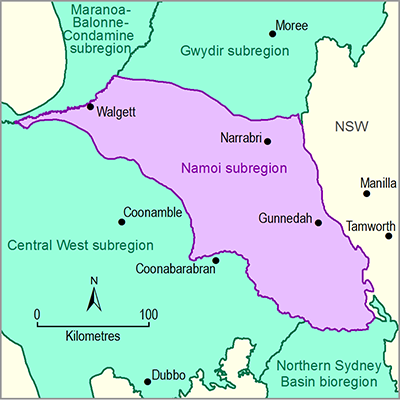- Home
- Assessments
- Bioregional Assessment Program
- Namoi subregion
- 5 Outcome synthesis for the Namoi subregion
- How could coal resource development result in hydrological changes?
The assessment identified potential hazards (Dataset 4) associated with coal resource development that could result in hydrological changes, such as aquifer depressurisation due to groundwater extraction. A hazard is a chain of events that begins with a coal resource development activity and results in hydrological changes. Causal pathways extend the chain of events to the potential impacts on ecosystems and assets resulting from these hydrological changes.
Hazards in scope were assessed by estimating relevant hydrological changes through hydrological modelling where possible, and then identifying potential impacts on, and risks to, water-dependent ecosystems and assets (described in the following sections).
In the BA context, four causal pathway groups summarise the causal pathways that commonly arise from coal resource development activities:
- ‘Subsurface depressurisation and dewatering’ is triggered by extraction of groundwater to enable CSG extraction, and dewatering of underground and open-cut mine pits. This potentially directly affects both local and regional groundwater systems, and indirectly affects surface water – groundwater interactions. Potential effects are likely to be in the short term (less than 5 years) for groundwater pressure changes, to long term (10 to 100s of years) for changes in groundwater movement or quality.
- ‘Subsurface physical flow paths’ are initiated by activities that cause physical changes to the rock mass or geological layers, resulting in new physical paths that water may potentially gain access to and flow along. Potential effects are in the medium (5 to 10 years) to long term and are likely to be restricted to aquifer or aquifer outcrop areas, but can also affect connected watercourses within and downstream of mines.
- ‘Surface water drainage’ starts with activities that physically disrupt the surface and near-surface materials (vegetation, topsoil, weathered rock). Medium- to long-term cumulative effects are possible for watercourses within and downstream of development. Activities may include construction of diversion walls and drains, interception of runoff, realignment of streams, and groundwater extraction for CSG production or underground coal mining leading to subsidence of land surface.
- ‘Operational water management’ is triggered by modification of surface water systems to allow storage, disposal, processing and use of extracted water. Potential effects are likely to be in the medium to long term and include impacts on watercourses within and downstream of operations.
Many activities related to coal resource development may cause local or on-site changes to surface water or groundwater. These are not considered explicitly in bioregional assessments because they are assumed to be adequately managed by site-based risk management and mitigation procedures, based on the licence conditions as summarised in the relevant environmental impact assessments, and are unlikely to result in cumulative impacts.
Conceptual modelling, product 2.3 (Herr et al., 2018b) Surface water numerical modelling, product 2.6.1 (Aryal et al., 2018a) Groundwater numerical modelling, product 2.6.2 (Janardhanan et al., 2018) Developing the conceptual model for causal pathways, submethodology M05 (Henderson et al., 2016) Systematic analysis of water-related hazards associated with coal resource development, submethodology M11 (Ford et al., 2016) Hazard analysis (Impact Modes and Effects Analysis) (Dataset 4) FIND MORE INFORMATION

Product Finalisation date
- Executive summary
- Explore this assessment
- About the subregion
- How could coal resource development result in hydrological changes?
- What are the potential hydrological changes?
- What are the potential impacts of additional coal resource development on ecosystems?
- What are the potential impacts of additional coal resource development on water-dependent assets?
- How to use this assessment
- Building on this assessment
- References and further reading
- Datasets
- Contributors to the Technical Programme
- Acknowledgements
- Citation
